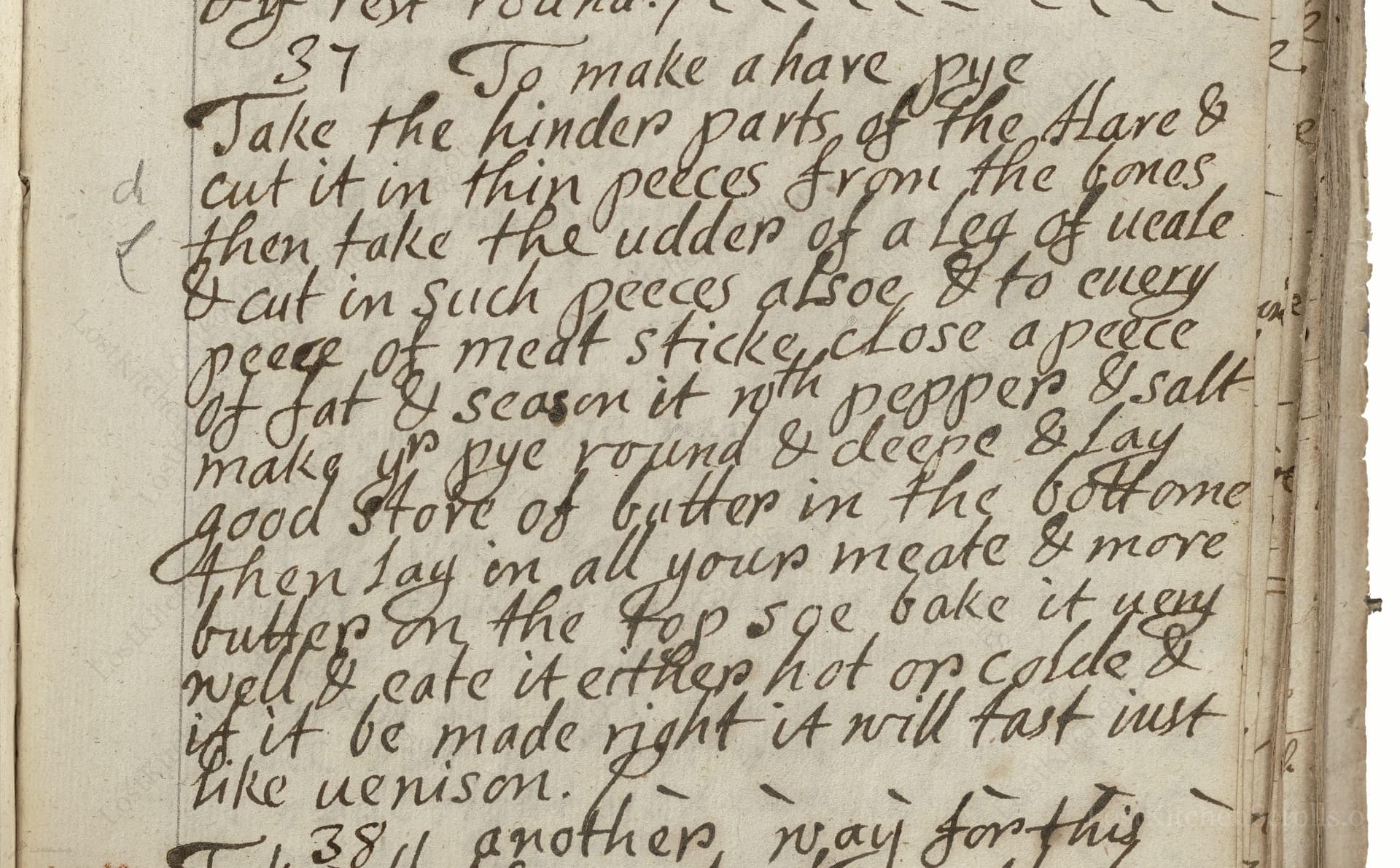To Make A Hare Pye
From the treasured pages of Cookbook of L. Cromwell
Written by L. Cromwell

To Make A Hare Pye
"Take the hinder parts of the Hare & cut it in thin peeces from the bones, then take the udder of a leg of ueale & cut in such peeces alsoe, & to euery peece of meat sticke close a peece of fat & season it with pepper & salt make yr pye round & deepe & lay good store of butterr in the bottome then lay in, all your meate & more butterr on the top soe bake it very well & eate it either hot or colde & if it be made right it will tast iust like uenison."
Note on the Original Text
The recipe is written in the direct, economical prose typical of 17th-century English cookery manuscripts. Instructions assume prior knowledge; details like quantities, temperatures, and times are omitted, as were customary when writing for experienced cooks. Spellings are archaic: 'pye' for 'pie', 'yr' for 'your', 'soe' for 'so', and 'just' appears as 'iust', reflecting the absence of standardized spelling in early modern English. Measurements are approximate and guided by tradition, observation, and taste.

Title
Cookbook of L. Cromwell (1650)
You can also click the book image above to peruse the original tome
Writer
L. Cromwell
Era
1650
Publisher
Unknown
Background
Step back into the sumptuous kitchens of the 17th century, where L. Cromwell’s collection stirs up a medley of grand flavors and old English culinary traditions—a true feast for culinary historians and curious cooks alike.
Kindly made available by
Folger Shakespeare Library
This recipe comes from the 17th century, during the era when England was shifting from medieval banquet feasts to the more refined and household-based dining culture of the Restoration period. It belongs to a manuscript possibly connected with the Cromwell family, a period marked by experimentation and adaptation within English kitchens. Game pies—particularly 'venison pies'—were esteemed dishes at gentry tables, symbolizing both hospitality and status. Hare was a common game meat, appreciated for its rich flavor and ability to mimic venison in pies for those unable to source the more prestigious deer meat. The use of veal udder reflects a nose-to-tail ethos and a penchant for luxurious textures and flavors among elite cooks.

A skilled cook of the 17th century would use a heavy, round earthenware or stoneware pie dish, a sturdy chopping knife, a wooden board, and perhaps a large mortar and pestle for grinding seasoned spices. Pastry would be rolled by hand with a wooden rolling pin, and the pie would be baked in a wood-fired oven or hearth, using embers to control heat. Fat for the recipe might have been rendered over open flame or collected from cooked meats.
Prep Time
30 mins
Cook Time
1 hr 30 mins
Servings
6
We've done our best to adapt this historical recipe for modern kitchens, but some details may still need refinement. We warmly welcome feedback from fellow cooks and culinary historians — your insights support the entire community!
Ingredients
- 1.3–1.75 lb hare hindquarter meat (or rabbit hindquarter as substitute), thinly sliced
- 9 oz veal udder (or 9 oz veal breast/shoulder as substitute), thinly sliced
- 3.5 oz pork back fat or lardo, cut into slivers
- 1.5 tsp (0.3 oz) sea salt
- 1 tsp (0.1 oz) freshly ground black pepper
- 14 oz unsalted butter, divided
- Pastry for pie lid (optional): about 14 oz shortcrust or hot water crust pastry
Instructions
- Begin by taking the hindquarters of a hare, or if unavailable, rabbit can serve as a substitute.
- Carefully debone and slice the meat thinly.
- Acquire 1 udder from a veal leg—if udder cannot be sourced, fresh veal breast or veal shoulder is a suitable alternative—and cut it into similarly thin pieces.
- To each piece of meat, attatch a small peice of pork back fat or lardo to mimic the original added fat.
- Season all meat generously with salt and black pepper.
- Prepare a deep, round pie dish.
- Place a layer of unsalted butter (about 7 oz) on the bottom, add the seasoned meats in layers, tucking in extra pieces of butter (around 7 oz more) on top.
- Cover with a shortcrust or hot water crust pastry lid if desired.
- Bake at 350°F for about 1.5 hours or until the meat is fully cooked and the pastry is golden.
- Serve hot or cold; when made with care, the flavors will evoke wild venison.
Estimated Calories
520 per serving
Cooking Estimates
Preparing and assembling the pie takes about 30 minutes, including slicing the meats and seasoning them. Baking the pie takes around 1.5 hours. Each serving contains about 520 calories. This recipe makes 6 servings.
As noted above, we have made our best effort to translate and adapt this historical recipe for modern kitchens, taking into account ingredients nowadays, cooking techniques, measurements, and so on. However, historical recipes often contain assumptions that require interpretation.
We'd love for anyone to help improve these adaptations. Community contributions are highly welcome. If you have suggestions, corrections, or cooking tips based on your experience with this recipe, please share them below.
Join the Discussion
Rate This Recipe

Den Bockfisch In Einer Fleisch Suppen Zu Kochen
This recipe hails from a German manuscript cookbook compiled in 1696, a time whe...

Die Grieß Nudlen Zumachen
This recipe comes from a rather mysterious manuscript cookbook, penned anonymous...

Ein Boudain
This recipe comes from an anonymous German-language manuscript cookbook from 169...

Ein Gesaltzen Citroni
This recipe, dating from 1696, comes from an extensive anonymous German cookbook...
Browse our complete collection of time-honored recipes



